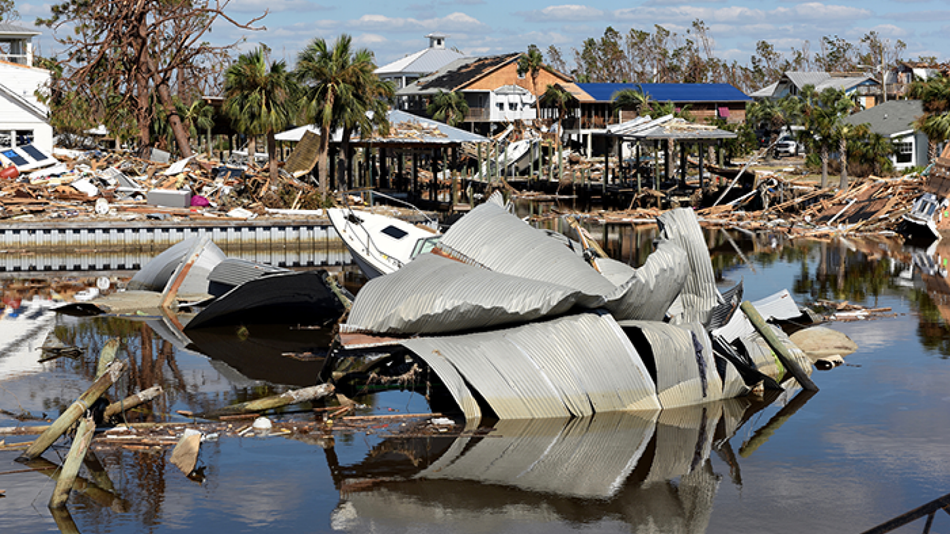When hurricanes strike land, they’re supposed to quickly lose steam. But as the oceans relentlessly warm and feed these storms more fuel, hurricanes are retaining intensity as they travel inland.
As atmospheric scientists put it, the storms aren’t “decaying” as quickly, which threatens inland areas with more destructive winds and rainfall. New research published Wednesday in the journal Nature analyzed landfalling Atlantic hurricanes between 1967 to 2018, and found as ocean temperatures rose, hurricane decayed more slowly. A powerful hurricane in the 1960s would retain about 25 percent of its intensity a day after hitting land. But today, that number has doubled to nearly 50 percent.
Warming oceans mean more slowly-decaying hurricanes, said Pinaki Chakraborty, a fluid mechanics researcher at the Okinawa Institute of Science and Technology Graduate University in Japan. Chakraborty, who studies atmospheric flows, is an author of the study.
Warm, bathtub-like sea surface temperatures (over 80 degrees Fahrenheit) are hurricane fuel. The storms convert evaporated moisture from these warm waters into energy and rain, which intensifies storms. (The physical process: Storms convert evaporated water vapor into ice particles, ultimately releasing energy that hurricanes convert to wind). Once a hurricane hits land, the storm loses the ocean and naturally begins to weaken as it encounters land (topography, buildings, vegetation, etc.). But today, because of warmer oceans, hurricanes have more fuel (evaporated moisture) in the tank to keep churning, so to speak. “This moisture fuels the slower decay,” explained Chakraborty.
“It’s fuel a hurricane can still use to not decay,” agreed Josh Alland, an atmospheric scientist at the National Center for Atmospheric Research. Alland had no involvement with the Nature study.
Chakraborty gave an example of two 156 mph hurricanes, one today and one 50 years ago. Both would travel some 270 miles in a day, after striking land. But a hurricane 50 years ago would weaken to some 38 mph, whereas a similar storm today would still pack winds of around 76 mph (hurricane-force winds).

Devastation from Hurricane Michael in Mexico Beach, Florida in October 2018.
Image: U.S. Coast Guard

Rising heat content in the oceans.
Image: noaa
In recent years, Alland has observed powerful hurricanes strike land but then be slow to lose intensity, like Hurricane Michael in 2018 and Hurricane Laura in 2020. “That the storms had a slower decay is concerning to me,” he said. After pummeling the coastal region in and around Mexico Beach, Florida, Hurricane Michael (which struck the coast as a Category 5 monster) still had enough fuel to produce “hurricane-force winds” in Albany, Georgia, over 100 miles inland. The hurricane retained a clear eye while spinning over land, said Alland, which is a sign of a potent, well-organized storm.
“Hurricanes are commonly known for devastating coastal impacts,” said Alland. “A lot of times it’s easy to forget about inland locations.”
In the coming years, decades, and well beyond, the oceans are expected to grow warmer. That’s because the seas absorb over 90 percent of the heat human traps on Earth. This translates to (on average) higher sea surface temperatures, and more favorable conditions for hurricanes to soak up evaporated moisture from the warming oceans. “In the future, sea surface temperatures are anticipated to increase in a warming climate,” said Alland. “With higher sea surface temperatures, the environment is anticipated to have more moisture.”
Future cyclones, then, are expected to hit land with a double whammy. Not only might the storms decay more slowly, they’ll likely have increased fuel to intensify into more powerful storms over the ocean, explained Chakraborty, meaning they’ll be more powerful even before they reach the coast (like Hurricane Michael or Laura).
Hurricane researchers have suspected for years that when a hurricane hits land, friction with the surface (from trees, topography, buildings, etc.) plays a dominant role in weakening the storms. But Chakraborty and his study coauthor also ran computer simulations of landfalling hurricanes. This showed landfalling storms carrying increased moisture decayed significantly more slowly.
“Friction is important but the moisture stored in a hurricane from its passage over the ocean plays a key role,” emphasized Chakraborty.
